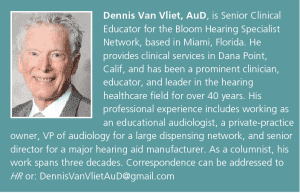Final Word | July 2018 Hearing Review
Mustard seeds—they’re small and tasty, and used for spicing up food as a seed or crushed into a powder. We are all familiar with the yellow mustard sauce used for hot dogs and similarly casual foods. My preference is grainy, spicy mustard accompanying sourdough rye bread, with any of a variety of different fillings.
Mustard seeds have also played a role in history. Many cultures have used mustard seeds in parables to illustrate different concepts. Christians describe how the small seed represents what can happen when a tiny start can grow to a size much larger than other herbs and provide shelter and benefit to many. The parable also represents the faith of the gardener that it will grow unassisted following planting. Muslims use the mustard seed as a symbol of the power of something very small, and that small things illustrate precision in the measure of all things. In Judaism, the mustard seed represents the concept of the benefit of conservation as opposed to waste. Wasting even a small thing such as a mustard seed, is to be avoided. Other references are found in Baha’i, Buddhism, Hinduism, and Taoism. Lessons and comparisons vary, but a common concept is that small tokens may grow into much larger and important items, and those who sow the seeds have faith that the germination and growth will proceed.
I thought about these comparisons the other day when I received a note from a patient who I first met in the late 1970s. He’s an engineer, and a musician (oh boy!) who led his life with an apparent moderate loss, but unaided, until he was about 40. He remembers not pronouncing a girlfriend’s name properly as a teen as a result of the loss, but managed to proceed through his formal education as an engineer and continued playing keyboard with various musical groups, unaided, until he was whacked in one ear with a tennis ball and suffered additional hearing loss. We struggled together through the years to achieve satisfactory results, most often ending up with compromises. His dilemma, which still continues today, is that when he is not actively listening for something, he is annoyed by ambient sound and conversation not important to him in that moment.
“I just don’t need to hear that!” is his common complaint. You can imagine how he reacted to his first fitting with a wide dynamic range system following a few years of compression-limiting linear amplification. He loved the fidelity but hated the additional audibility.
He contacted me recently, not because he was having any trouble with his hearing aids, but to ask about referring someone who is having trouble with hearing aids and needs help. He wrote, “I can’t overstress the importance I put on having the right person [to help with hearing]. I am so fortunate as to have had you. Hearing aid fitting is complicated and sensitive.”
I was pleased that he remembered our efforts in such a positive light. There was a time that he focused much more on the product than the service I provided. As I look back, I planted the seeds of professional standards of care along with patient and empathetic interactions that caused him to have faith in my guidance. Those initial seeds grew into a decades-long enjoyable professional relationship for both of us.
In these disruptive times, we are struggling with the creation and implementation of fair models for compensation. On a daily basis, I find myself seeing what needs to be done for patients and moving ahead with appropriate care, but also planting seeds of information to help them understand that a change from the bundled model they may have purchased their hearing aids under to a fairer, fee-for-service model will be offered in the future. I’m not entirely sure yet how smooth the transition will be, but the goal is that the yield of the unbundled model will be transparent and fair to provider and patient alike.
The Final Word? As we transition from the traditional bundled service model into a fair and transparent fee-for-service system, one challenge will be to foster recognition of the value that we bring to the table. What may be something we document as a clean and check is, in reality, a communication assessment update, otoscopic examination, cerumen management, coupling assessment involving replaceable tips and filters, or an earmold cleaning and tubing change, and, perhaps, a quick coupler or probe-mic assessment. I think listing these important and valuable services in a review of what was done as the office visit is finishing up plants the seeds of good value that should help our future harvest.
Citation for this article: Van Vliet D. Planting the seeds of value in hearing care. Hearing Review. 2018;25(7):50.
Image: © Amenic181| Dreamstime.com






